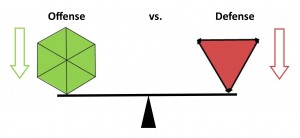“The best offensive is to eliminate your opponent’s defense.”
Offense is the concept of actively forcing an action or event on the Target.
Defense is the concept of actively resisting this action or event by the Target.
The concepts of Offense and Defense have no attached or intrinsic value judgments of good and bad.
When the Offensive is greater than the Defense it succeeds. When it is equal or less than the Defense it fails. Increasing Offensive effectiveness makes it more likely that the intended action will succeed. Increasing Defensive effectiveness through makes it more likely that the intended Offensive action will fail.
Understanding Defense makes it easier to successfully apply effective Offense. Understanding the Offense makes it easier to apply effective Defense.
“The best defense is a good offense.” – Maxim
Translation – An effective Offense is an important aspect of an effective Defense. Also known as the concept of “Attack the attacker”
“The best offensive is to eliminate your opponent’s defense.”– Erik K.
Translation – No matter how weak or ineffective your offense is, if your opponent has no defense you will prevail.
Many times it is easier to eliminate or remove your opponent’s defense than to increase your own offense. It takes effort to increase your offense capability and effectiveness. Once you have reached a certain level of offensive capability, further increases are marginally more difficult.
If you are a dedicated martial artist, you may be willing to put in the time and effort for self-improvement. But what if you are a street thug, common criminal, or human predator? The easiest method to insure your success is to assault people with no or little defensive capability. Why is this easy? Because you get to choose who you assault, when you want to assault them, where you assault them, and with what tools.
In a civilized society, a person’s defensive capabilities are the sum of their internal ability (what they can do) and their external ability (what others can do for them). For example, while most people can steal candy from a baby, the baby’s defense extends to its care givers and other who may choose to intervene on its behalf. Taking the candy is only half the battle. Success also requires getting away without consequences. I call this defensive external ability, the Institutional Fence.
It is common for many cynical people to claim that the Institutional Fence will not protect them. That the police are slow to arrive. That help may never come. While this fact may be true in some situations, it is not true in most situations. In a civilized society, help does arrive sooner or later. It may arrive too late. But the threat of arrival still exists.
What the cynics are forgetting is that the mere threat of the Institutional Fence has an effect on an aggressor, whether or not help actually arrives in time. The “bad guy” is at-risk. Therefore, predatory people systematically reduce risk by accurate victim selection.
The low hanging fruit of the Victim Tree are those that both have minimal defenses and are either unable or unwilling to seek help before, during, or after the crime (have certain Factors).
1. Silent Victims – Afraid to resist and unwilling to seek help. In this case, the Predator uses familiarity with the victim to determine who to assault. This person is the lowest risk victim (lowest hanging fruit) for the Predator.
2. Passive Victims – Afraid to resist and willing to seek help after the assault. In this case, the Predator needs to conceal his identity to not get caught. This person is a low risk victim (low hanging fruit) for the Predator.
3. Vulnerable Victims – Unable to successfully resist and willing to seek help after the assault. This person is more risky since he or she makes an attempt to resist. This resistance increases the odds that the Predator may be identified or that help may arrive from the Institutional Fence.
4. Hard Targets – Able to resist and willing to seek help. This person represents the greatest risk to the Predator. The Predator needs to employ strategies to overwhelm his victim as quickly as possible for success. He needs to shield his identity to ward off consequences from the Institutional Fence.
It is clear that the Predator, who has the luxury of selecting his victim, has the ability to choose the potential victim that is perceived to offer the greatest odds of success. His odds are increased by selecting a Silent or Passive Victim with no/low defense as opposed to a Hard Target with a stronger defense.
If the Predator increases his offense by employing a weapon, he also increases the severity of his punishment if convicted. Therefore, the safest strategy involves selecting a low risk victim who is afraid to resist and unwilling to engage the protection of the Institutional Fence. For the Predator, It is safer to lower the victim’s defense (by selection) than to increase his offense.
This rational explains why the majority of victims of sexual assault both know their attacker and also do not report the crime. The victims were not chosen at random. They were accurately selected as low hanging fruit offering minimal risk to the attacker. This logic also explains why most of these assaults involve threats as opposed to force. The use of force is not needed and using it increases the risk posed by the Institutional Fence.
Those that want to minimize the risk of selection for easy victimization need to convey their willingness to actively resist and willingness to actively seek the help of the Institutional Fence. They are now perceived as Hard Targets, the least desirable victims of Predators.
